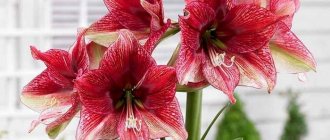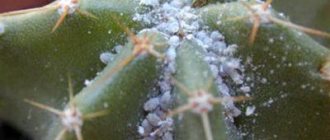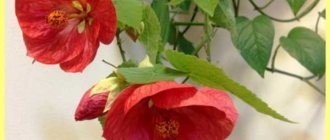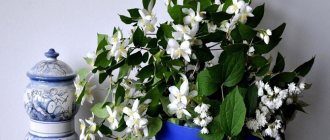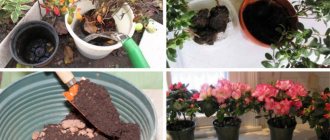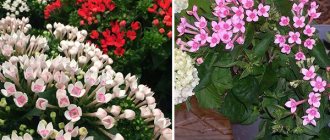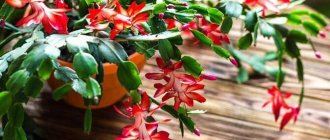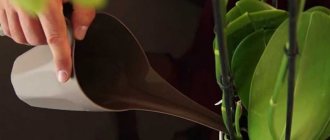Jasmine is part of the olive family (Oleaceae). Science knows two hundred species of shrubs and vines that are common in the tropics and subtropics of Europe and Asia.
According to one version, jasmine comes from Iran; according to another, India is considered to be its homeland.
Indoor jasmine is often confused with garden mock orange, which cannot be distinguished from real jasmine from a photo, although these plants have different botanical characteristics, and jasmine needs different care.
Not all jasmine can be grown indoors. In order for jasmine to feel comfortable indoors, certain rules must be followed.
Homemade jasmine and its types with photos
Jasmine is an evergreen shrub or vine. The flowers grow individually or form a racemose multi-flowered inflorescence.
The plant can be erect or with ampelous shoots. The bottom of the stem becomes woody over time, so new shoots are directed in an arc.
At home, it is possible to grow four types of indoor jasmine, photos of which are presented below.
Jasmine multiflora (polyanthus)
Climbing shrub. The height of the plant reaches two meters. The buds are pink, and white flowers grow five or six at the top of each shoot.
Jasmine polyanthus begins to bloom in February and ends only at the end of summer. This variety is considered the most fragrant of all.
Jasmine holoflora (“winter jasmine”)
The drooping shoots of the bush are covered with small trifoliate leaves of bright green color.
In winter, leaves may fall off. Winter jasmine flowers are yellow and grow in the corner between the stem and leaf.
This jasmine is odorless. Holofloral jasmine flowers appear in winter.
Jasmine officinalis (large-flowered)
The jasmine species Jasminum grandiflorum is a climbing shrub with long, thin and angular branches on which grow two- or three-paired leaves with a smooth surface and cilia along the edge.
The top of the leaf is lighter than the bottom. White flowers form umbrella-shaped inflorescences. Large-flowered jasmine begins to bloom in April.
Sambac (Arabian, Indian jasmine)
Jasmine sambac is a vine about 6 m long with thin, drooping shoots. The ovoid leaves grow opposite each other and reach up to ten centimeters. White flowers are collected in umbrella inflorescences.
Sambac blooms from mid-spring to mid-autumn and tolerates winter indoors well. Indian jasmine flowers are sometimes added to tea. Prepared soil for begonias is suitable for planting.
Caring for indoor jasmine
Indoor jasmine receives care at home in two stages: the flower requires attention immediately after planting and during the growing process.
The first two months the plant does not require special care. It is necessary to monitor the soil moisture and spray the jasmine leaves with water. Then the first fertilizing is applied.
For an adult plant, the following care procedures are necessary:
- regular feeding;
- mulching;
- pruning
Before caring for indoor jasmine, it is important to learn simple principles that will help maintain the health and lush color of the plant.
Healing properties
The benefits of jasmine flowers are due to the high content of many essential acids and essential oils. Leaves and flowers, due to the presence of salicyl-containing elements in them, have mild antiseptic properties sufficient to disinfect cuts.
Essential oils and flower decoctions are widely used as a tonic that has a beneficial effect on all organ systems, especially the nervous one.
There is also a positive effect on the female body during lactation and menstruation. Medicines for insomnia and migraines are prepared from the roots.
People with hypertension and stomach ulcers, as well as allergy sufferers, should be careful when using jasmine.
Temperature, humidity, watering
Jasmine loves light, but direct sun is contraindicated for it. It is best to place the flowerpot on the east or west side. Direct sunlight can be diffused using transparent fabric.
It is prohibited to place jasmine on the north side: jasmine grows slowly in such conditions.
Help: in summer, the flower can be placed on the balcony, but not in direct sun. This can cause burns on the leaves, so the light level should be changed gradually.
Temperature
In winter, the temperature is maintained within 13-17 degrees. In spring and autumn, it is recommended to maintain a temperature of 18-23 degrees.
In summer, the room temperature should not rise above 24 degrees. Otherwise, the flowerpot is kept in the open air and regularly sprayed with water.
Humidity
The air in the room should not be too dry. To humidify, you can use a spray bottle or special humidifiers.
Watering rules
Jasmine needs moderate humidity. The soil should not be allowed to dry out, but excessive moisture can lead to rotting of the roots.
In summer, the plant is watered three to four times a week. In spring and autumn, you can limit yourself to three waterings a week, and in winter, when jasmine blooms, it is watered once every 4-5 days.
The rest of the time in winter, the flower is watered when the top layer of soil dries out.
Description
Mock orange is a plant from the Hydrangeaceae family. In Russia, the hollow shoots of this plant have long been used to make a chibouk - part of a pipe for smoking.
This shrub is popularly called jasmine because of the similarity of the aroma and color of its flowers with some varieties of indoor jasmine.
Popular rumor says that garden jasmine is the key to happiness and good luck.
There is a version that garden jasmine came to our country in the 17th century from Germany during the reign of the Romanov dynasty.
There are several versions of the origin of garden jasmine. According to one legend, an angel, wanting to make people's lives more beautiful, descended from heaven and turned into a jasmine bush. The ancient Greeks believed that the fragrant bush with charming white flowers was the work of the goddess of wisdom, Athena. Be that as it may, even now jasmine symbolizes love and evokes romantic associations.
The flowering time for mock orange is in the summer and lasts about three weeks. All varieties of this shrub shed their leaves in winter. The height of the shrubs varies: from seventy centimeters to 5 meters and above.
Planting and replanting jasmine
It is best to plant indoor jasmine in the spring. It is usually propagated by cuttings.
For rooting, cuttings are placed in water or wet sand. The rooting period is at least two months.
The jasmine pot should be spacious, but not too large, because at first the jasmine needs to be replanted every year. It is important to provide the pot with good drainage, since stagnation of water will destroy the roots of the plant.
For support I use a special ladder or wire arc.
For planting, use soil for house plants or a mixture of compost, coarse sand and turf soil.
Jasmine transplant
Indoor jasmine is replanted annually until it grows, providing proper care at home. Then the plant needs to be replanted every three to four years.
Advice: it is better to replant in the spring, after the flowering period has ended.
For transplantation you need:
- Prepare the pot.
- Make drainage.
- Water the bush and remove it from the old pot along with a lump of soil.
- Place the jasmine in a new pot and add fresh soil.
- Water the plant and return it to its usual place.
Pot for transplanting
The new pot should be no more than 2-3 cm larger in volume than the old one.
If the pot is too large, the soil will begin to sour. It is better when the roots completely entwine the earthen ball.
Soil selection
Jasmine takes root in neutral or slightly acidic soil.
It includes:
- peat; leaf and turf soil;
- greenhouse substrate;
- river sand.
The components are mixed in equal proportions, and river sand is added in an amount of ½.
Ready-made substrate can be purchased at a specialty store.
Preparing for winter
In order for the plant not to die in winter, it must be properly prepared for this difficult period. To do this, you need to perform a few very simple manipulations:
- It should be remembered that adult specimens are more frost-resistant than young ones. Therefore, it is quite possible not to prepare adult plants for the winter period. However, those jasmines that are still quite young need this procedure.
- When the bush fades, it should be wrapped in material specially designed for this. You can also use regular straw for this purpose.
- To prevent jasmine roots from being damaged during the winter cold, in the autumn you need to dig up the soil around the trunk and do not forget to add compost to it.
- If desired, this shrub can be transplanted to a new place in the spring.
Fertilizers and fertilizers
During the active growth stage, the crop should be fertilized frequently: at least once a week. Fertilizers for flowering plants are used for feeding.
Jasmines do not accept long-acting fertilizers, so it is better to opt for classic liquid fertilizers.
After flowering ends, fertilizer is stopped, continuing only when signs of growth appear.
Propagation of indoor jasmine
Jasmine propagation occurs in the following ways:
- seeds;
- cuttings;
- layering;
- division of the rhizome.
More often, decorative hybrids are sold in the form of seeds, which do not retain their parental properties, so it is better to use cuttings or layering.
When cuttings, it is important that the length of the shoots is at least 5 cm and that there are no signs of damage or disease. It is not recommended to select growth shoots for propagation by cuttings, since they do not take root well.
Jasmine should be propagated by layering in the spring, but they can only be dug up for replanting in October, having previously been divided by the number of shoots.
Dividing the rhizome of indoor jasmine is a simple method of propagation, in which flowering can be achieved in a few months.
Features at home
If you plan to use jasmine as an indoor flower, then it should be placed in spacious rooms. A powerful aroma is wonderful in an open garden, but in a confined space its abundance can have a detrimental effect on well-being.
The plant itself can suffer from the wrong location and tap water. Sun rays refracted through double-glazed windows can burn delicate foliage, causing it to yellow and die.
Butterflies: beautiful creatures from the world of insectsHow to grow excellent petunia seedlings
- How to properly water an orchid in a pot: the benefits of automatic watering for the plant
The same goes for hard tap water. To avoid these troubles, you need to use a softening filter and choose a place without excessive sunlight.
If these conditions are met, but your bush still does not want to bloom, most likely there were errors during planting in the form of too deep grounding. The solution is to replant so that the rhizome sticks out of the ground a little. The cause may also be insufficient soil acidity, which can be solved with appropriate fertilizers.
Diseases and pests of jasmine
Most often, indoor jasmine suffers from spider mites, aphids and whiteflies. At the same time, the culture is quite resistant to various diseases.
Whitefly infestation is indicated by curling, yellowing and falling leaves. The drugs Actellik, Intavir and Agravertin help combat the pest.
When attacked by spider mites, jasmine leaves turn yellow and fall off. In case of severe damage, the plant is treated with Actellik solution.
Due to the cobwebs with which the aphids entangle the tops of the bush, growth slows down, which will lead to drying out of the plant. A solution of Iskra Bio will help fight aphids.
Growing problems
Despite the unpretentiousness of the plant, every gardener from time to time faces force majeure circumstances. In order not to lose the bush, and also to continue to enjoy its appearance and aroma, you need to be prepared for such situations and know what to do.
Pay attention to the information on how to get rid of black aphids on jasmine.
Why do the leaves turn black?
It happens that the foliage on a jasmine bush begins to turn black and curl. Many summer residents are afraid of fungal diseases, however, the problem lies elsewhere. Often, especially inexperienced gardeners, trying to do the best for the plant, add too much fertilizer, thereby damaging the root system.
The way out of the situation is to add a biostimulant to the soil: for example, just one ampoule of Zircon will be enough for 10 liters of water.
Causes of yellowing leaves
The most common cause of yellowing leaves is insufficient watering or nutrients in the soil. In the latter case, fertilizers that contain nitrogen may be required. Drying of the leaves can be caused by a fungal disease (for example, gray rot) or a root collar that is too deep.
In the first case, it is recommended to carry out systematic preventive treatment with the participation of fungicidal and insecticidal preparations (depending on the type of disease), in the second - to free the bush at the base from excess soil with the onset of spring.
The appearance of pests
Jasmine is rare, but can be attacked by various types of insect pests. The most common of them include:
- Spider mite - a small insect (no more than 5 mm), which, feeding on the sap of a plant, entangles its foliage with a web. As a result, small spots of light yellow color can be seen on the surface of the plant. To combat the pest, bushes are treated with acaricides or insecticides at least 2 times, at intervals of 10–14 days.
- Weevils - small beetles that, despite their size, can lead to the destruction of an entire plant. In order to get rid of pests, jasmine is treated with chlorophos, and if the number of pests, insects, and their larvae is small, they are collected and destroyed manually.
In general, jasmine is one of the plants that does not require careful care. Sufficient watering and annual fertilizing will provide the garden with beautiful flowering shrubs, which will delight you with its exquisite aroma for a long time. We should not forget about timely pruning, because this procedure not only makes it possible to obtain the desired shape of the bush, but also acts as a prevention of various fungal diseases, which, if they occur, can easily spread throughout the entire area.
Signs and superstitions about indoor jasmine
There is a belief that jasmine “scares off” men. In the rituals of the peoples of the Middle East and Asia, jasmine truly symbolizes purity and purity.
At the same time, in the East, jasmine is considered an aphrodisiac and is used in love magic to bring harmony to marriage.
It is also believed that if jasmine blooms in a house where an unmarried woman lives, then she will soon get married.
Well-groomed and lushly blooming jasmine will become the pride of every gardener. Before growing jasmine indoors, it is worth learning how to care for it and how it reproduces.
